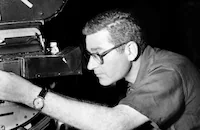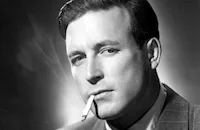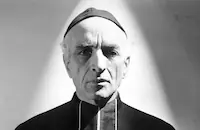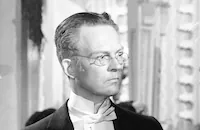Youth Runs Wild

Brief Synopsis
Cast & Crew
Mark Robson
Bonita Granville
Kent Smith
Jean Brooks
Glenn Vernon
Tessa Brind
Film Details
Technical Specs

Synopsis
After a three-year absence, Mary Coates returns to her parents' home on Euclid Street to find the neighborhood changed by the ongoing war. Her parents, the Hausers, are working the night shift at a defense plant while her fifteen-year old brother Frankie has been truant from school. Mary is upset by Frankie's attachment to Sarah Taylor, the eldest daughter of the Hausers' lowbrow new neighbors. When Sarah's parents selfishly insist that she cancel her birthday date with Frankie and babysit her younger siblings so that they can attend a party, Sarah sneaks out of the house to meet Frankie. Frankie, who does not have enough money to take Sarah on a real date, confides that he wants to quit school and get a job.
The next morning, Mary receives a telephone call notifying her that her husband, Danny Coates, a war hero who has been awarded the Purple Heart, is being released from the hospital and will return home the following day. That night, as Sarah finishes serving dinner to her siblings, her parents return home with some boisterous friends and commandeer the table to play a game of cards. When one of the men begins to leer at Sarah, her mother tells her to leave the house, so she goes to the movie theater in search of Frankie. Larry Duncan, the owner of a garage that fences stolen automobiles, and his girl friend Toddy offer Sarah a ride to the theater. When the usher says that Frankie is not there, Larry invites Sarah to join them at Rocky's Café, a nightclub. Meanwhile, Frankie, to avoid paying admission, has sneaked into the theater through a side door.
After he hears that Sarah has been seen with Larry, Frankie is berated by Herb Vigero, his tough-talking friend, who suggests they go to work for Larry. When Frankie, Herb and another friend appear at Larry's garage in search of a job, Larry's garage manager sends them to steal tires from parked cars. Larry, learning of their assignment, races to stop them because he was an old schoolmate of Mary's and feels protective toward Frankie. Meanwhile, at a parking lot, the boys begin to steal a tire when a telephone linesman spots them and calls the guard. Larry arrives just as the boys speed away, and when the guard shoots, he hits Larry. As Toddy drives the wounded Larry to his garage, the boys are arrested for speeding. After calling an ambulance, Toddy leaves Larry at the garage and takes Sarah with her. The next day, Danny arrives home on crutches and learns that Mary is at juvenile court with Frankie. Danny, still wearing his uniform, rushes to the courthouse, and the judge, impressed by the soldier's medals, paroles Frankie and his friends into Danny's custody. When they return home, Mrs. Hauser and Mary, who blame Frankie's delinquent behavior on the "new people on the street," ask Frankie to stop seeing Sarah.
Soon after, an unattended child is hit by a car, prompting Mary and Danny to discuss solutions to the problem of child neglect created when both parents are working at defense plants. To help alleviate the problem, Mary decides to open a daycare center in the Hausers' backyard, and Danny plans to teach his wards how to work with tools and other useful skills. After Frankie informs Sarah that he can no longer see her, Toddy stops by and asks Sarah to visit Larry in the hospital for her. Toddy is on probation and therefore unable to visit Larry, who is under arrest, and so Sarah agrees to go in her stead. After the visit, Toddy takes Sarah to an amusement park to cheer her up, and when they miss the last bus back to town, they spend the night at Rocky's Café.
When Sarah returns home the next morning, her abusive parents throw her out of the house. Toddy, identifying with the girl's alienation, takes her home and gets her a job at Rocky's. Weeks later, after Frankie confides to Danny that he blames himself for Sarah leaving home, Danny promises to talk to Sarah for him. At Rocky's, Sarah, now working as a bar hostess, tells Danny that she is no longer a child and hopes that Frankie will forget her for his own good. Unable to accept Sarah's rejection, Frankie and his friends drive to the club to talk to her. When Frankie apologizes to Sarah and says that he loves her, she berates him and asks Rocky to throw him out. Angry at the treatment of his friend, Herb insists on entering the club and starts a fight. In the mêlée, Toddy is injured and later dies in her hospital bed as Larry and Sarah helplessly watch. Frankie is brought to trial, and although the judge admits that society's ills are caused by the breakup of the family, he sentences Frankie to eighteen months in Forestry Camp.
After Danny and Sarah bid Frankie farewell, Danny comforts Sarah with the story of Ruth Clifton, a teenager who founded a youth recreation center in Moline, Illinois, to help eliminate the problem of juvenile delinquency. Inspired by Ruth's example, Sarah goes to join the cause.

Director

Mark Robson
Cast

Bonita Granville

Kent Smith

Jean Brooks

Glenn Vernon
Tessa Brind
Ben Bard
Mary Servoss

Arthur Shields

Lawrence Tierney

Dickie Moore
Johnny Walsh
Rod Rodgers

Elizabeth Russell
Juanita Alvarez
Gloria Donovan
Jack Carrington
Ida Shoemaker
Claire Carleton
Art Smith
Harold Barnitz
Peter Dane
Margaret Landry
Harry Clay
Teddy Infuhr

Lee Phelps
George Denormand
Frank O'connor
Joan Blair
Steve Winston
Ruth Alvarez

Molly Lamont
Danny Desmond

Fritz Leiber
Robert Strong
Tom Burton

Russell Hopton
Chris Drake
Edmund Glover

Dorothy Malone
Daun Kennedy
Michael Road
Don Kerr
Les Clark

Gordon Jones
Harry Harvey

Don Dillaway
Maxwell Hayes
Jack Gargan
Bud Wiser
Rosemary Laplanche

Joan Barclay
Crew
C. Bakaleinikoff
Mel Berns
Carroll Clark
Ruth Clifton
Albert S. D'agostino
Harry D'arcy
Madeleine Dmytryk
Ross Dowd
John Fante
John Fante
Herbert Kline
Val Lewton
John Lockert
Frank Mcwhorter
John S. Mescall
Paul Sawtell
Darrell Silvera
Edward Stevenson
Vernon L. Walker
Ardel Wray

Videos
Movie Clip





Trailer
Film Details
Technical Specs

Articles
Youth Runs Wild
The semi-exploitative social commentary film Youth Runs Wild (1944), however, was a bit of an anomaly in Lewton's career. That may be because the subject matter is so far afield from the rest of Lewton's output. Ironically, Lewton had lobbied hard for a non-horror project, and was handed one that the RKO brass hoped would match such sensationalistic past successes as Edward Dmytryk's Hitler's Children (1943) and Behind the Rising Sun (1943). Another reason may be Lewton's own notorious disavowal of the finished work, which the studio heavily doctored after a disastrous test screening. Still, there is much to commend the film, particularly for the perspective it grants on a prevalent social ill of its era.
Inspired by a Look magazine article and mounted under the working title of Are These Our Children?, the scenario dealt with the steady increase of juvenile delinquency in the U.S. caused by the upsurge in parental absenteeism due to the war effort. The drama unfolds as two working-class households are depicted. Mary Hauser (Jean Brooks), a young wife awaiting her wounded husband's return from service, lives with his hard-working parents. Their odd hours mean that she spends nearly as much time parenting her own toddler as she does being a surrogate to her teenage brother-in-law Frankie (Glenn Vernon) who's beginning to have trouble with truancy.
Amongst Frankie's distractions is his new girlfriend, Sarah Taylor (Tessa Brind), whose home life makes Frankie's seem normal by contrast. Her loutish parents (Ben Bard, Elizabeth Russell) keep her pressed into endless household service, and prefer to spend whatever downtime they have partying. These kids are ripe for temptation, which comes in the form of the sleazy young tire bootlegger Larry Duncan (Lawrence Tierney) and his too-easy companion Toddy (Bonita Granville). It isn't long before Frankie is drifting into tire theft, and Sarah moves in with Toddy to begin apprenticeship as a B-girl. When Frankie's brother Danny (Kent Smith) finally arrives home, he pours his energies into bringing some semblance of order to both his family and the community at large.
Lewton began with the best of intentions on Youth Runs Wild, offering a consultancy to Ruth Clifton, an Illinois teenager who instituted a youth center movement in her hometown in response to the problem and inspired others nationwide to do the same. The preproduction ballyhoo, however, only drew the attention of the U.S. State Department, which voiced its own reservations about the subject matter as being detrimental to the nation's security and morale. "Lewton argued that the intent of the film was to draw attention to a national problem and help bring about measures to solve it, which would do the country more good than harm," Edmund G. Bansak wrote in his biography Fearing the Dark: The Val Lewton Career (McFarland & Co.) "RKO decided not to pull the film from active production, but because of its controversial subject matter, Lewton was given more supervision than usual, much to his displeasure."
The studio renamed the project The Dangerous Age for release. After a preview marred by the antics of a loud drunk, a jittery RKO yanked the film back for extensive reworking. An entire subplot involving one teenage boy's murder of his abusive father was dropped completely. The conflicts of the story, and the greater issues that they raised, wound up getting resolved a little too neatly. Lewton's subsequent demand to have his name removed from the picture was denied by RKO. While Youth Runs Wild won't likely find a spot in the upper tier of his legacy, it remains an earnest attempt to address a significant problem that still echoes in society generations later.
Producer: Val Lewton
Director: Mark Robson
Screenplay: John Fante, Herbert Kline, Ardel Wray
Cinematography: John J. Mescall
Film Editing: John Lockert
Art Direction: Carroll Clark, Albert S. D¿Agostino
Music: Paul Sawtell
Cast: Bonita Granville (Toddy), Kent Smith (Danny Hauser), Jean Brooks (Mary Hauser), Glenn Vernon (Frank Hauser), Tessa Brind (Sarah Taylor), Ben Bard (Mr. Taylor).
BW-67m.
by Jay S. Steinberg

Youth Runs Wild
TCM Remembers - Lawrence Tierney
A SCREEN TOUGH GUY WHO WAS MEANER THAN A JUNKYARD DOG
Lawrence Tierney, one of the screen's toughest tough guys, died February 26th at the age of 82. He first startled audiences with his impassioned work in the 1940s but Tierney's rowdy off-screen life eventually pushed him out of the limelight. Though he kept working in small parts, Tierney found a new generation of fans with a few memorable roles in the 80s and 90s.
Tierney was born March 15, 1919 in Brooklyn, New York. He grew up in New York and was a track star in school before becoming interested in acting. (His two brothers also became actors though they changed their names to Scott Brady and Ed Tracy.) He went through the usual period of stage appearances before getting bit parts in little-remembered films. His first credited role was in Sing Your Worries Away (1942) but Tierney quickly made his mark playing the title role in Dillinger (1945). A string of memorable roles followed in films like San Quentin (1946), The Devil Thumbs a Ride (1947), Born to Kill (1947) and the Oscar-winning circus drama from director Cecil B. DeMille, The Greatest Show on Earth (1952) in which Tierney played the villain responsible for the epic train wreck toward the film's conclusion. However, Tierney had a knack for real-life trouble and was arrested several times for disorderly conduct and drunken driving. By the end of the 50s he only found sporadic acting work, sometimes not working for several years between films. During this period his best-known work was in Custer of the West (1967) and Andy Warhol's Bad (1977).
Slowly in the 1980s, Tierney landed small but frequently noticable parts in Hollywood films such as Prizzi's Honor (1985) and The Naked Gun (1988). He appeared on TV shows like Hill Street Blues, Star Trek: The Next Generation and Seinfeld (as Elaine's father). In 1992 that changed when Quentin Tarrantino cast Tierney as the crime boss in Reservoir Dogs, an unforgettable part that gave him new fans. While the subsequent roles or films didn't get any bigger, Tierney was finally a recognized name. One of his oddest roles was the half-hour Red (1993) based on the infamous mid-70s Tube Bar tapes where a real-life bar owner responds with startlingly over-the-top remarks to prank phone calls. (If that sounds familiar it's because The Simpsons based Moe's responses to prank calls on these tapes. Tierney provided a voice in the 1995 Simpsons episode "Marge Be Not Proud.") Tierney's last film appearance was in Armageddon (1998)!
By Lang Thompson
CHUCK JONES, 1912 - 2002
Animator Chuck Jones died February 22nd at the age of 89. Jones may not have boasted quite the name recognition of Howard Hawks or John Ford but he was unquestionably one of the greatest American directors. His goals might have been primarily to entertain, which he did so wonderfully that his 50 and 60 year old cartoons seem fresher than most anything produced in the 21st century. But Jones displayed a sense of movement, timing and character barely equalled elsewhere. Literary critics have a saying that while there are no perfect novels there are certainly flawless short stories. Several of Jones' cartoons reach a perfection that Hawks and Ford could only have dreamed about.
Jones was born September 21, 1912 in Spokane, Washington but grew up in Hollywood. As a child he would watch films by Charlie Chaplin and others being made in the streets, absorbing the process and supposedly even appearing as an extra in Mack Sennett shorts. After graduating from L.A.'s Chouinard Art Institute (now California Institute of the Arts), Jones started selling pencil drawings on street corners. He soon landed a job in 1932 with ground-breaking animator Ub Iwerks as a cel washer (somebody who removes ink from the expensive celluloid frames so they could be reused). The following year Jones began to work for Leon Schlesinger Productions which was sold to Warner Brothers. There he directed his first film, The Night Watchman in 1938.
Jones would stay at Warners for almost 25 years until it closed the animation division. Here is where Jones did some of his most-beloved work, putting Bugs Bunny, Daffy Duck, the Road Runner, Marvin Martian and numerous others through many of their most memorable exploits. Who can forget Bugs and Daffy's hilariously convoluted arguments about hunting season in Rabbit Seasoning (1952) and Duck Rabbit Duck (1953)? Or the Coyote's tantalized, endless pursuit of the Road Runner? What's Opera Doc? (1957) sending Elmer and Bugs to Bayreuth? A cheerfully singing and dancing frog that, alas, only performs for one frustrated man? Daffy tormented by the very elements of the cartoon medium in Duck Amuck (1953)? That's only a fraction of what Jones created while at the Warners animation studio, affectionately known as Termite Terrace. This building on the Warners lot boasted an array of individualist talents that Jones, like Duke Ellington, could pull into a whole. There was voice artist Mel Blanc's impeccable timing, writer Michael Maltese's absurdist love affair with language, music director Carl
Stalling's collaged scores and perhaps best of all a studio that knew enough to just leave the gang alone so long as the cartoons kept coming.
After Warners shuttered its animation division in 1962, Jones moved to MGM where he worked on several Tom & Jerry cartoons, his inimitable lines always immediately apparent. In 1966 he directed How the Grinch Stole Christmas from Dr. Seuss' book, one of the finest literary adaptations. A feature version of Norman Juster's classic The Phantom Tollbooth followed in 1969. Along with his daughter Linda, Jones was one of the first to see the value of original animation art and in the late 70s began a thriving business. (For more info see http://www.chuckjones.com.) Jones made cameo appearances in Joe Dante's Gremlins (1984) and Innerspace (1987). In 1989, he wrote a touching and funny memoir, Chuck Amuck, that's pretty much essential reading.
Jones won an Best Short Subject Cartoons Oscar for The Dot and the Line (1965), having earlier been nominated twice in 1962. His Pepe LePew film For Scent-imental Reasons (1949) and public-health cartoon So Much for So Little also won Oscars though not for Jones himself. In 1996 he was awarded an honorary Oscar "for the creation of classic cartoons and cartoon characters whose animated lives have brought joy to our real ones for more than a half century."
By Lang Thompson
GEORGE NADER, 1921 - 2002
Actor George Nader, best known for the B-movie anti-classic Robot Monster, died February 4th at the age of 80. One-time co-star Tony Curtis said, "He was one of the kindest and most generous men I've ever known. I will miss him." Nader was born in Pasadena, California on October 19, 1921 and like many other actors started performing while in school. His first film appearance was the B-Western Rustlers on Horseback (1950) and he made other appearances, often uncredited, before the immortal Robot Monster in 1953. This dust-cheap, charmingly inept film (originally in 3-D!) features Nader as the father of Earth's last surviving family, everybody else having been wiped out by a gorilla in a diving helmet. Shortly after, Nader landed major roles in RKO's Carnival Story (1954) and with Curtis in Universal's Six Bridges to Cross (1955), bringing a beefy charm that earned him numerous fans. As a result, in 1955 Nader shared a Golden Globe for Most Promising Male Newcomer. He then appeared in numerous lower profile studio films before closing out the decade playing Ellery Queen in a short-lived TV series. He relocated to Europe in the sixties where he found steady work. As secret agent Jerry Cotton, he made a series of spy thrillers which earned him a cult reputation in Europe, starting with Schusse aud dem Geigenkasten (aka Operation Hurricane: Friday Noon) (1965). The eighth and final entry in the series was Dynamit in gruner Seide (aka Dynamite in Green Silk) (1968). His film career ended in the mid-70s when a car wreck damaged his eyes so that he could no longer endure a film set's bright lights. Nader began writing novels, most notably the recently reprinted Chrome (1978), an acclaimed science fiction novel with openly gay characters.
By Lang Thompson
TCM REMEMBERS HAROLD RUSSELL, 1914 - 2002
Oscar-winning actor Harold Russell died January 29th of a heart attack at age 88. As a disabled veteran whose hands had been amputated in The Best Years of Our Lives (1946), Russell won Best Supporting Actor but also an honorary award "for bringing hope and courage to his fellow veterans." This made Russell the only person to receive two Oscars for the same role. Russell was born in Nova Scotia on January 14, 1914 but grew up in Cambridge Massachusetts. He joined the US Army after the attack on Pearl Harbor and while training paratroopers lost both hands in an accidental explosion. He then made a training film where director William Wyler saw Russell. Wyler was so impressed that he changed the character in The Best Years of Our Lives from a man with neurological damage to an amputee so that Russell could play the part. After winning the Oscar, Russell followed Wyler's advice and went to college, eventually running a public relations company and writing his autobiography. He made two more film appearances, Inside Moves (1980) and Dogtown (1997), and appeared in a few TV episodes of China Beach and Trapper John MD. Russell made waves in 1992 when he decided to sell his acting Oscar to help cover expenses of his large family. The Motion Picture Academy offered to buy the statue for $20,000 but it sold to an anonymous bidder for $60,000. About the other statute, Russell said, "I'd never sell the special one. The war was over, and this was the industry's way of saying thank you to the veterans."
By Lang Thompson
TCM Remembers - Lawrence Tierney
Quotes
Trivia
Notes
The working titles of this film were The Dangerous Age, Look to Your Children and Are These Our Children. According to pre-production news items in Hollywood Reporter, director Edward Dmytryk was initially assigned to the film, but left the project to direct Tender Comrade. Eve March was tested for a leading role, but does not appear in the picture. According to another news item in Hollywood Reporter, photographer John Mescall experimented with a new lens called the "swivel lens" in order to produce a depth of focus nearing infinity for scenes in the picture. Ruth Clifton, the technical advisor on the film, founded a youth recreation center in Moline, IL designed to address the problems of juvenile delinquency. Herbert Kline, one of the film's writers, was a noted director of documentary films.
News items in Hollywood Reporter and Los Angeles Examiner note that RKO tried to lend authority to the film by screening it for agencies like the State Juvenile Delinquency Authority and the Los Angeles Youth Activities Committee. Despite its claims of authenticity, the picture was poorly received. In a telegram contained in the RKO Legal Files, a Look spokesman described the film as an "outworn, stale documentary," and the magazine refused to allow its name to appear in screen credits or to promote the film in any way. Although some prints for the film [including the print initially viewed for this entry] did not credit the Look photo essay which inspired the film, others contained the statement "Inspired by the Look Magazine Picture Story 'Are These Our Children.'"
A memo contained in the legal files written by Val Lewton to Charles Koerner, the then head of the studio, reveals that RKO previewed two different versions of the film (hence the two copyright numbers assigned to the picture). RKO recut Lewton's original version, excising several scenes, including those concerning an abused teenage boy and his sadistic father, according to a modern source. The picture was a failure at the box office and lost $45,000, according to the RKO Archives Production Information Files at the UCLA Arts-Special Collections Library. The picture has no connection to the 1931 RKO film titled Are These Our Children?, although they are both about juvenile delinquents. Youth Runs Wild marked the motion picture debut of actress Vanessa Brown, who appeared under the name Tessa Brind. Prior to coming to Hollywood, Brown had been on the Broadway stage and had appeared on the popular radio program Quiz Kids.















